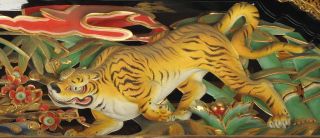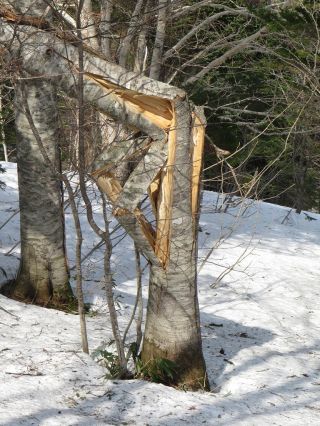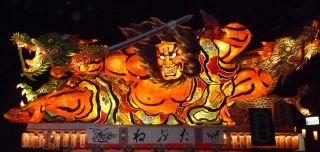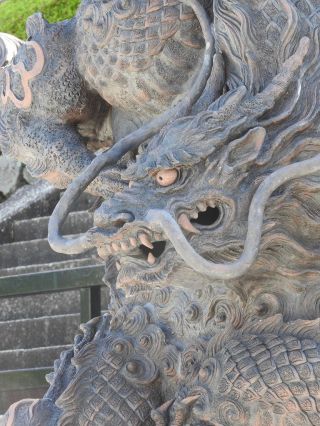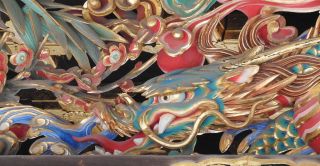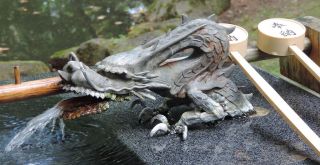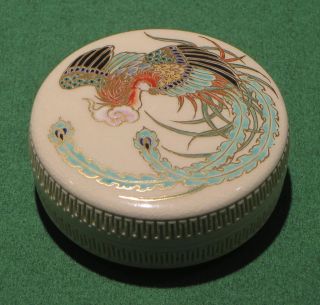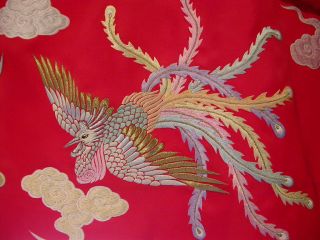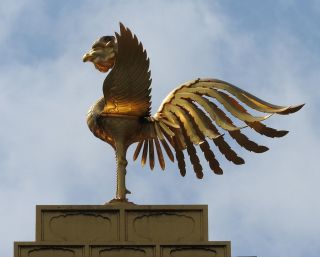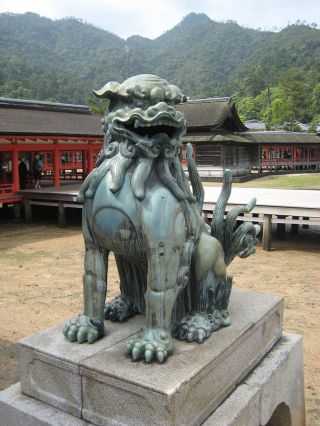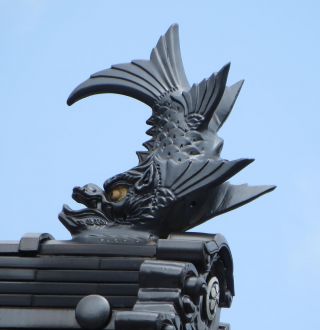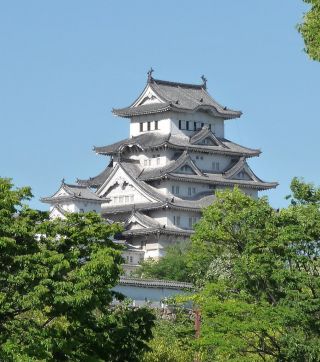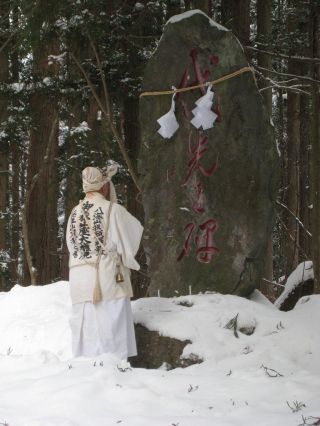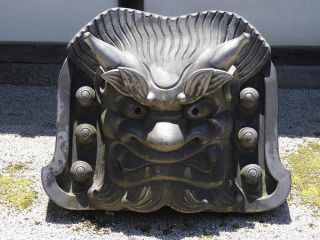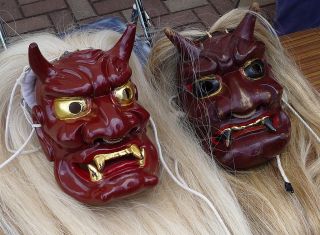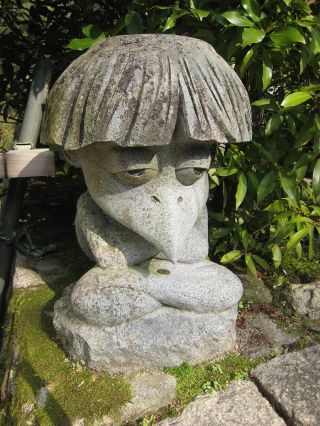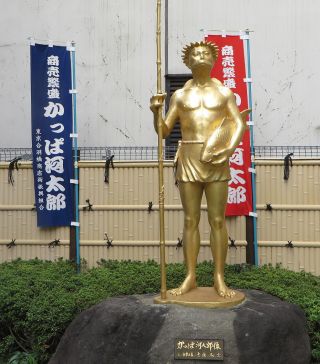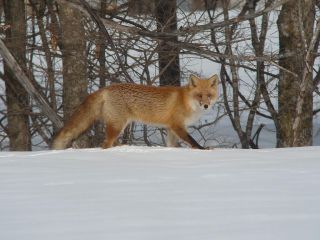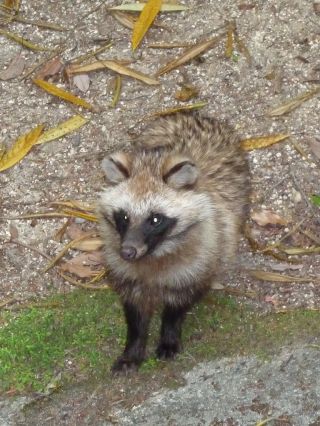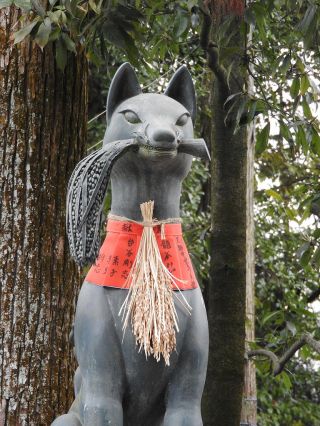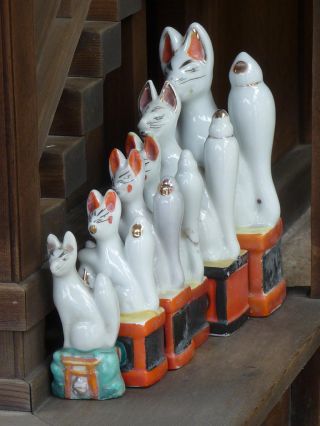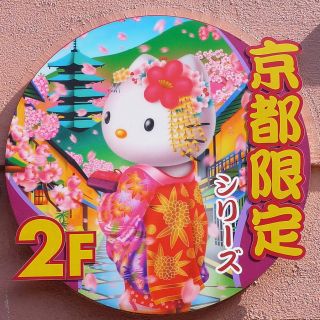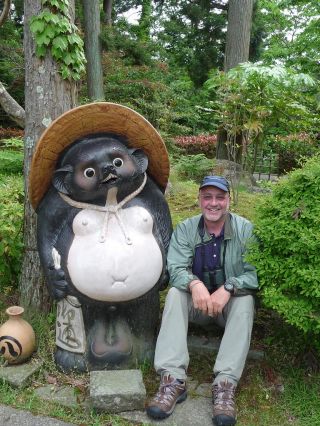Japanese Tiger, Nijo Castle, Kyoto © Mark Brazil
Japan’s Mythical Beasts and Where to Find Them
By Mark Brazil | Apr 20, 2017
From water shrews to whiskered bats and tree-climbing long-haired rats, and from sea otters and stoats to bears, macaques and boars, Japan has a wonderful mammalian bestiary. Amphibians and reptiles abound too, from diminutive tree frogs to giant salamanders – enough to keep any mammal watcher or herpetologist busy from Okinawa to Hokkaido, and new species continue to be found. The explorations of fossil hunters continue to add also to Japan’s known ancient biodiversity, which already ranges from dinosaurs to mammoths. With thousands of islands to explore, there is so much natural history here to unearth – living and dead.
There is of course, as any observant traveller through these isles will attest, another somewhat bewildering side to Japan’s natural history – its “un-natural history.”
Mythical creatures roam this archipelago from mountaintops to ocean deeps. Are they cultural fossils, remnants of past oral traditions telling of creatures that really once lived here?
Do folklore and fable tap into our deep consciousness of creatures past that once frightened and perhaps even fed on our distant ancestors? Into this category we might list both elephant and tiger, as their depictions can be found at numerous shrines around Japan. We know that they roamed here once many thousands of years ago; could they actually be ‘remembered’? Or are they instead flights of fancy, figments of imagination, contrived merely to teach a new generation a collective lore containing information and wisdom, teaching what to respect and what to fear. Why though do we find depictions of elephants and tigers, but not of boars and bears, swans, snakes or bats?
As thunder storms roll and rattle around Japan’s alpine peaks, as typhoon clouds unleash curtains of rain that lash and batter at the archipelago, and as winter winds howl between branches and shake the forest canopy, the rocks and trees themselves creak and groan alarmingly as if they are fearful of what attacks them.
Wind gusts batter; rocks boom and smash and branches fall; trunks crack and burst. Storm waves crash and surge, seemingly intent on devouring the coast. The ground moves beneath us, literally, shaken by massive quakes; earth trembles and slips; slick mud slides; snow avalanches.
Wall-like tsunami arise and hurtle ashore like bullet train battering rams, destroying all in their path. Mountains burst into life vomiting lava, ash, and unwholesome, even deadly, gases. The percussive cacophony of storms in the mountains or on the coast, the immense powers shaking the Earth and driving walls of water ashore are terrifying – even when their causes are well understood.
Imagine then the possible ignorant interpretations of natural phenomena during more suspicious times. Were they the antics of giants at play, or at war, amongst the peaks, or of gods angered by the works of men? Were they the wrath of winged dragons bearing down raining fire, or of wingless dragons awakening angry in the ocean deeps? Were they ravenous goblins or horned demons running amok in the forests? Or were they strange creatures in the flood-swollen rivers and in the surging waves.
Leaving the familiar safety of one’s village behind meant that at every turn there were risks and dangers, and even while at home the earth’s upheavals could be terrifying. Survival was to be found more readily amongst the familiar (whether location or ritual), within the community than with out it.
Was there any better way to teach children about the dangers of venturing into those unfamiliar realms than by means of folk tales that populated them with fearsome creatures? Folktales and myths foster beliefs and gods, monsters and beasts; they are all created and sustained by belief, hope and a fair dose of fear.
Perhaps it is that sense of fear that has led to the diversity and wide-ranging depictions of dragons that appear in so many parts of Japan. Did people genuinely believe in and fear dragons here, were images of these mythical creatures attempts to appease them, or constant reminders of their potential for destructive power?
Embodying both storm god and sea serpent, today’s dragons may not circle above active volcanoes or crawl about in remote mountains or emerge from the deep ocean, but you can find them for sure, in Okinawa, Kyushu and Honshu – that is if you know where to look.
Prime habitat for dragons (ryu) seems to be around Shinto shrines. Look for them sneaking about beneath the eaves of ancient shrines, or weaving through wooden transoms in old castles. Look for them dissolving through screens, and re-appearing on tsuba (sword guards) on inro (seal cases) and netsuke.
In their form as water deities, dragons bring protection against fire for wooden structures. And wherever you find a dragon look sharply, there may be a phoenix (hou-ou) about. This massive bird has, since ancient times, been considered a good omen, representing justice, fidelity, obedience, fire and the sun (among other things). The phoenix too inhabits shrines and castles.
With the dragon symbolizing masculinity and the phoenix femininity, they may appear together representing wedded bliss, but they may be either lovers or eternal enemies. Alone, the phoenix can be a symbol of the imperial household, or a symbol of peace, with the bird’s appearance coinciding with peace and prosperity and its disappearance with disharmony.
Fascinatingly, in both their ancient and modern interpretations in Japan, the phoenix appears to resemble rather closely the peacock of South Asia, complete with crown, long train of tail feathers, and long legs.
Japan’s phoenix is a far cry from the west’s creature born of fire and ash, yet its name can also be read as the bird that never dies, making it a potent symbol of life and death and so very suitable to keep around a shrine.
Echoing the role of the dragon as a protector from fire, we also find the shachihoko. This wide mouthed mythical sea creature is capable of swallowing everything, including fire and lives most commonly on the main roof ridges of buildings.
Although sometimes mistakenly described as a dolphin, shachihoko is said to have a carp’s arched tail, a tiger’s immense head and a dragon’s scales, and it is believed to draw down rain and keep fire at bay. Those characteristics make it a potent symbol, and you will find it frequently on tiled-roof wooden buildings, most notably on lavish houses and on castles around the country.
Less fearsome than the dragon, less fickle than the phoenix, and less chimeric than the shachihoko, in the Japanese bestial menagerie at least, is the Lion Dog, komainu or shishi. Komainu are stoical creatures, never moving, they can be found day and night sitting on their haunches, serving as guardians at the entrances of many a shrine or temple ready to ward off evil spirits.
Komainu live in pairs, but never have young. One, with its mouth open, sits opposite a second with its mouth closed. They call back and forth to each other, one saying "a" the other saying "um" the first and last letters of the Sanskrit alphabet. Together their duet forms the word Aum, the sacred sound of Buddhists.
In Japanese, the komainu say “a” and “n” of the Japanese syllabary; they are the alpha and omega, the beginning and end. However, these strange Japanese creatures appear more catlike than doglike and are a far cry from a real lion, but then creatures on islands frequently diverge significantly from their ancestral stock. In southern Japan, in Okinawa, there is an endemic local form known as shisa, which can be found standing guard on rooftops and at the entrances of houses and shops.
Water is revered in Japan, as the antidote to fire, as the source of irrigation for the all important rice crop, and the source of the water is in the mountains. Until relatively recently entry into those mountains was taboo, except for yamabushi, Shinto mountain ascetics or shamans. After all, it was in those very mountains that so many of the spirits, demons and deities of Japan resided.
Both oni and tengu are yokai (supernatural monsters or demons) of the mountains. We might consider them both to be ogres, devils or trolls, but here in Japan oni are characterised by red or blue skin, hideous faces, wild hair and long horns.
Oni often carry iron clubs and wear tiger-skin loincloths (so there must have been tigers here!) and are considered immensely powerful, even invincible. They may be considered invincible, but I have witnessed people throwing dried soybeans at them to keep them away during Setsubun. Amazingly this seems to work, and I have yet to meet any soybean wielder who has been harmed by an oni. Apart from living in the mountains you may also find them hiding amongst decorative roof tiles.
Mountain streams form an important habitat in Japan, and one of the strange creatures that lives there is the kappa (or kawatora – literally river tiger). This river demon or imp is, in Shinto at least, a water deity, whereas for Buddhists it is a hungry ogre. Their plethora of regional names indicates that they are ubiquitous, even if rarely seen today.
These scaly-skinned roughly humanoid creatures are typically green or blue, though occasionally they appear gold. They have webbed hands and feet suited to their riverine habitat, where they hunt for fish… and other things! Uniquely, in a hairless depression in the very top of their skull kappa carry their watery habitat with them whenever they must leave their riverine homes. In some regions kappa are believed to live in water only during spring and summer, they can cover their watery pileum with a metal cap and live away from water, in fact they may spend the remainder of the year in the mountains where they are revered as mountain gods.
Variously seen as mischievous or malevolent tricksters, the pranks of the kappa range from sneaking peaks beneath women’s clothing to kidnap, rape, drowning, and even eating human flesh. Search for them along riverbanks anywhere in the mountains of Honshu, Shikoku or Kyushu, I have not heard of any here in Hokkaido, and have never seen one myself, but do be aware of their danger.
Should you be confronted by a kappa while wandering near a river, remember that they are averse to iron, ginger, and sesame, and can be driven away if you are armed with these. Just in case you don’t have iron, ginger or sesame at hand, then remember that kappa are, despite their malevolent reputation, polite. So, when meeting one for the first time bow deeply and it will respond in kind, thereby spilling the water, its life force, from its crown. Losing its precious water will render it unable to move. Provide a refill of water from its river and the kappa will serve you for life.
Perhaps kappa live quietly alongside us, hiding and keeping out of sight, or perhaps tales of the kappa were invented to warn children of the dangers of playing by the river, where sudden floods and the gaping maws of giant salamanders await them.
Where mountain river waters spread out and form marshes their lived, in historical times, the Tancho. Instead of a watery crown, this creature, believed to live for a thousand years and to bring happiness, has blood red crown. Tancho has retreated northwards and today it is confined to Hokkaido, but historically it lived further south and, based on the many old illustrations I have seen, it lived in pine-trees!
Around the margins of the marshes live two more strange creatures, kitsune and tanuki, both with the remarkable capacity to change their shape, their colour and their form.
Kitsune are living creatures with mischievous alter egos. They are capable of shape shifting and renowned for playing tricks; often spiteful ones. Tanuki meanwhile is another living creature with similar shape-shifting capabilities, but it is considered friendly and helpful at best, or at worst a bumbling, tipsy creature beloved of saké drinkers.
The classic folktale of Bunbuku Chagama relates how a tanuki, after being rescued from a trap by a poor man, used its shape-shifting ability to thank its saviour. To earn the poor man money the tanuki transformed itself into a tea kettle and offered to be sold for cash.
Unfortunately, the monk who purchased the kettle put it to use boiling water over a fire. Unable to stand the heat, the tanuki transformed again and ran back to its rescuer. The tanuki’s next idea was to set up a circus stall and allowed spectators to watch him (in his kettle shape) walk on a tightrope, for an admission fee of course. So doing, the poor man gained an income and the tanuki gained a friendly home.
The fox is the most frequent variant of the komainu guardian of shrines dedicated to the deity of rice – Inari. There are thousands of Inari shrines across Japan and a pair of foxes guards each of them. One of the pair has a rolled Buddhist text or sutra in its mouth, while the other holds a precious jewel or a key to the grain store. If they are painted, these guardians are invariably white, indicating that they possess magical powers and are messengers of the gods.
Among the strangest of Japanese creatures, is a small cat without a mouth. Known bizarelly as Hello Kitty (a.k.a. Kitty White), she can be found throughout the country from Hokkaido to Okinawa, often in disguise, and dressed as almost any regional species, from deer to crested ibis, from marimo to maiko.
With so many creatures to look for in Japan, it is surprising that no-one has produced a field guide to them, depicting their features and describing their habits and habitat. Watch out for them wherever you are, they may be hiding in plain sight.
Outro
If you would like to read more about Japan’s natural (and un-natural) history, then you may enjoy Mark’s most recent book, a collection of essays entitled The Nature of Japan.
Author, naturalist, lecturer and expedition leader, Dr Mark Brazil has written his Wild Watch column continuously since April 1982, first in The Japan Times for 33 years, and since 2015 here on this website. All Wild Watch articles dating back to 1999 are archived here for your reading pleasure.
Two handy pocket guides The Common and Iconic Birds of Japan and The Common and Iconic Mammals of Japan have also been published and along with The Nature of Japan are available from www.japannatureguides.com

